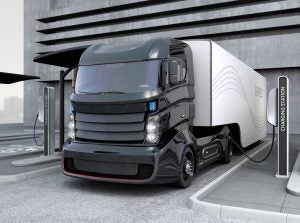 This week, hundreds of officials from countries, states, cities and companies all over the world are convening in New York to discuss the future of our planet. Among the many solutions being discussed is one that sometimes gets less attention, but holds tremendous opportunity to tackle climate change and clean our air in communities across the globe: zero-emission trucks and buses.
This week, hundreds of officials from countries, states, cities and companies all over the world are convening in New York to discuss the future of our planet. Among the many solutions being discussed is one that sometimes gets less attention, but holds tremendous opportunity to tackle climate change and clean our air in communities across the globe: zero-emission trucks and buses.
I attended an event hosted by CALSTART where they presented information on their Global Commercial Vehicle Drive to Zero Program. This international initiative focuses on driving market development of zero-emission medium- and heavy-duty vehicles through partnerships that promote supporting policies and investments. We also heard from leading government and corporate players like the New York State Energy Research and Development Authority, the Port Authority of New York and New Jersey, FedEx and INGKA (formerly the IKEA Group) on the progress they are making to electrify their fleets. As Angela Hultberg, Head of Sustainable Mobility of INGKA, made clear, we are past the point of making commitments, we need to move to implement.
The global transportation sector is expected to be the largest source of growing emissions through 2050, not to mention a major contributor to ozone and particulate pollution in local communities. The majority of this growth will come from the freight movement as expanding economies increasingly rely on shipping and delivery.
But what many people don’t know is that within this growing source of global emissions, medium- and heavy-duty vehicles — like large delivery trucks, port vehicles and buses — account for nearly 60% of this growth and are projected to rival passenger vehicles as the largest source of transportation greenhouse gases by 2050.
Zero-emission trucks and buses can improve our climate, clean air future Click To TweetBecause climate change and air pollution are linked — the sources of the emissions that cause them are often the same — these emissions will also be responsible for serious air-quality impacts to human health. In 2015, diesel-powered vehicles were the largest contributor to premature deaths globally caused by transportation pollution — many of these are concentrated in urban areas and disadvantaged communities.
Herein lies a huge opportunity to improve air quality, reduce carbon emissions and curtail global oil demand. It’s time to transition the world’s trucks and buses to zero-emission alternatives.
Transforming the transportation sector from fossil fuels to zero-emission has remarkable promise. But it comes with equally remarkable challenges. For example, truck fleets usually drive all day and would need to charge at night. That creates a supply and infrastructure dilemma for local utilities that would have large and new loads to satisfy in the evening.
Balancing the significant lifetime cost savings of electric trucks and buses with their upfront costs is also challenging. While a recent analysis by the California Air Resources Board found that battery electric trucks will be cost competitive with a wide range of diesel trucks by 2024. In the interim, we need to pursue a variety of financing and grant solutions that will accelerate adoption of these vehicles to deliver their significant climate and air quality benefits today.
At EDF, our staff is working on these two primary challenges in an effort to catalyze the electrification of transportation.
- We’re working with utilities on grid modernization, new rate design and infrastructure improvements that will help local utilities and fleet owners meet the new charging demands of truck fleets with clean electricity.
- We’re developing new financial tools and solutions that will increase the adoption of electric trucks in key sectors by reducing up-front costs and attracting new sources of capital.
- We’re partnering with fleet operators to deploy electric trucks and catalyze manufacturer and third-party investments in key market segments.
- And we’re advancing new policies at the local, state and federal level that drive investment in charging infrastructure.
According to our analysis of Bloomberg New Energy Finance data, more than half of trucks on the road in the U.S., Europe and China will still be fossil-fueled by 2050. But to achieve the targets set out under the IPCC’s sustainable development scenarios (to stay below 2 degrees Celsius), this percentage needs to come way down. In fact, the vast majority of global fleets must be made up of zero-emission vehicles by 2050. This requires virtually all new sales of medium- and heavy-duty vehicles in the U.S., Europe and China to be zero-emission by 2040.
To achieve this ambitious goal, we must dramatically accelerate the adoption of ZEVs globally — for the benefit of our climate and the billions of people around the world who deserve cleaner and healthier air.